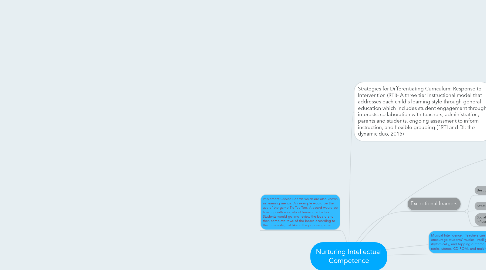Nurturing Intellectual Competence
by Tabitha Dugger


1. Implement Choice Boards which are also known as learning menus. An example would be the use of the game Tic-Tac-Toe. A board would be filled up with a variety of learning activities. Students would go and review the board and then complete rows of the board according to their interests, just like in the popular game.
2. Strategies for differentiating curriculum
2.1. Utilizing Learning Contracts
2.2. Offer alternate activities
3. Diverse Learning Needs: Incorporating Multiple Intelligences (Adapted from INTERNATIONAL JOURNAL OF SCHOLARLY ACADEMIC INTELLECTUAL DIVERSITY VOLUME 16, NUMBER 1, 2014)
3.1. Interpersonal Intelligence:Teachers can encourage the growth of interpersonal intelligence by designing lessons that include group activities, seminars, and dialogues. Tools include the telephone, audio conferencing, time and attention from the teacher, video conferencing, writing, computer conferencing, and email.
3.2. Naturalist Intelligence:Teachers can enhance this intelligence by having students differentiate among living things (plants, animals), demonstrate sensitivity to the natural world (clouds, rock configurations) through the study of relationships such as pattern recognition and comparison and contrast and connections to real life and science issues.
4. Intrapersonal Intelligence: Teachers can encourage growth of intrapersonal intelligence by assigning reflective activities, such as journal writing and independent study. Tools include books, creative materials, diaries, privacy and time.
5. Logical-Mathematical Intelligence: Teachers can strengthen this intelligence by encouraging the use of computer programming languages, critical–thinking activities, linear outlining, science-fiction scenarios, logic puzzles, and through the use of logical-sequential presentation of subject matter.
6. Can be taught the same social and emotional skills or intervention for any specific skill where there is gap to grow in standards or skills based instruction. These types of decisions are based on the observations of regular education classroom teacher, ESE facilitator, or Interventionists that progress monitor the student.
7. Musical Intelligence: Teachers can integrate activities into their lessons that encourage students’ musical intelligence by turning lessons into lyrics, speaking rhythmically, and tapping out time. Tools include musical instruments, music, radio, stereo, CD-ROM, and multimedia.
8. Provided specially designed instruction in their least restrictive environment with an individualized IEP.
9. Linguistic Intelligence: Teachers can enhance their students’ linguistic intelligence by having them say and see words, read books together, and by encouraging discussion. Tools include computers, word games, multimedia, books, tape recorders, and lecture.
10. Bodily-Kinesthetic Intelligence: Teachers may encourage growth in this area of intelligence through physical activity, hands-on learning, acting out, role playing, and physical relaxation exercises. Tools include equipment and real objects.
11. Spatial Intelligence: Teachers can foster this intelligence through drawings and verbal and physical imagery. Tools include models, graphics, charts, photographs, drawings, 3-D modeling, video, videoconferencing, television, multimedia, texts with pictures/charts/graphs, microscopes, computer graphics software.
12. Exceptional learners
12.1. Best practices for developing the whole child
12.1.1. Inclusion Classrooms: opportunities and responsibilities that are available to all students in the school.

